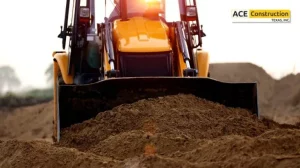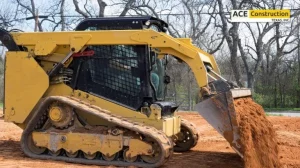Dirt work in construction often plays the understated, foundational role compared to the more visible phases of building and design. Yet, it establishes its significance through its essential preparation, ensuring a project’s stability and longevity. This foundational stage distinguishes itself by offering a critical base that supports the entire construction process, making dirt work a category integral to construction in its own right.
Key activities within dirt work include Excavation, Grading, Compaction, and sometimes Land Clearing, each known for their specific contributions to site preparation. Excavation is notable for creating space for foundations and utilities, while Grading ensures a level base or a specific slope for drainage. Compaction increases the density of the soil, providing the necessary support for the structure’s foundation, and Land Clearing removes any vegetation or obstacles from the site.
Digging deeper, I see that each type of dirt work brings its techniques, equipment requirements, environmental considerations, and challenges. The following sections will detail these facets, offering a comprehensive understanding of the pivotal role dirt work plays in the construction industry and why it’s considered the unsung hero of building projects worldwide.
Why is dirt work crucial in construction projects?

Dirt work is the cornerstone of construction projects because it lays the groundwork for a stable and enduring structure. Ensuring a level foundation prevents future issues, such as cracks or settling arising from uneven soil distribution. Additionally, practical dirt work facilitates proper drainage, directing water away from the building site to avoid water damage or foundation erosion.
This stage of construction is not just about moving soil; it’s about safeguarding the project’s integrity from the ground up, making it indispensable for the success and longevity of any construction endeavor.
Ensures a stable and level foundation for structures
Dirt work plays a pivotal role in setting the stage for secure construction. By meticulously leveling the ground and preparing the site, it guarantees that the foundation is stable and level, which is crucial for the structure’s longevity and safety.
Prevents future structural issues due to soil settlement
Soil settlement can lead to significant structural problems, including cracks in the foundation, walls, and floors. Dirt work employs compaction and other techniques to minimize the risk of soil settlement, thereby shielding the structure’s future integrity.
Facilitates proper drainage away from the building site
Adequate drainage is vital to safeguard a construction site from water damage. Through strategic Grading, dirt work ensures water is directed away from the building, preventing issues like erosion or foundation damage that can undermine the structure’s stability.
Real-life Examples and Statistical Data
- Example 1: The Millennium Tower in San Francisco, which has experienced significant tilting and settling issues, underscores the importance of comprehensive dirt work. Initial investigations pointed to inadequate soil analysis and preparation, highlighting how crucial thorough dirt work is for high-rise buildings.
- Example 2: The Leaning Tower of Pisa is a historical example of inadequate soil compaction and preparation. Modern stabilization efforts have involved extensive soil extraction and compaction techniques to prevent further tilting, demonstrating the critical role of dirt work in preserving structures.
- Statistical Data: According to a study by the American Society of Civil Engineers, over 25% of structural failures are attributed to poor soil preparation and compaction, underscoring the vital importance of practical dirt work in construction projects.
What are the primary types of dirt work?

The primary types of dirt work, essential for the success of any construction project, include Excavation, Grading, and Compaction. Excavation involves removing soil to create spaces for foundations or utilities, laying the groundwork for the subsequent stages of construction. Grading involves leveling or sloping the ground, which is crucial for ensuring proper drainage and a stable base for construction activities.
Compaction aims to increase the soil density, providing the necessary support and stability for the structure’s foundation. Each of these types addresses different aspects of ground preparation, ensuring that the site is ready to support the demands of the construction project.
Excavation: Removing soil to create holes or trenches
Excavation stands out as a fundamental process in dirt work. It focuses on removing soil to establish holes or trenches or to clear the way for foundational structures. This phase is pivotal, setting the stage for the construction of buildings, roads, and essential utilities and ensuring a solid foundation is in place.
Grading: Leveling or sloping the ground for drainage
Grading involves meticulously leveling or sloping the ground, a critical step to facilitate proper drainage and prevent water from pooling near the construction site. This process not only safeguards the site from potential water damage but also contributes to the long-term stability and integrity of the project.






